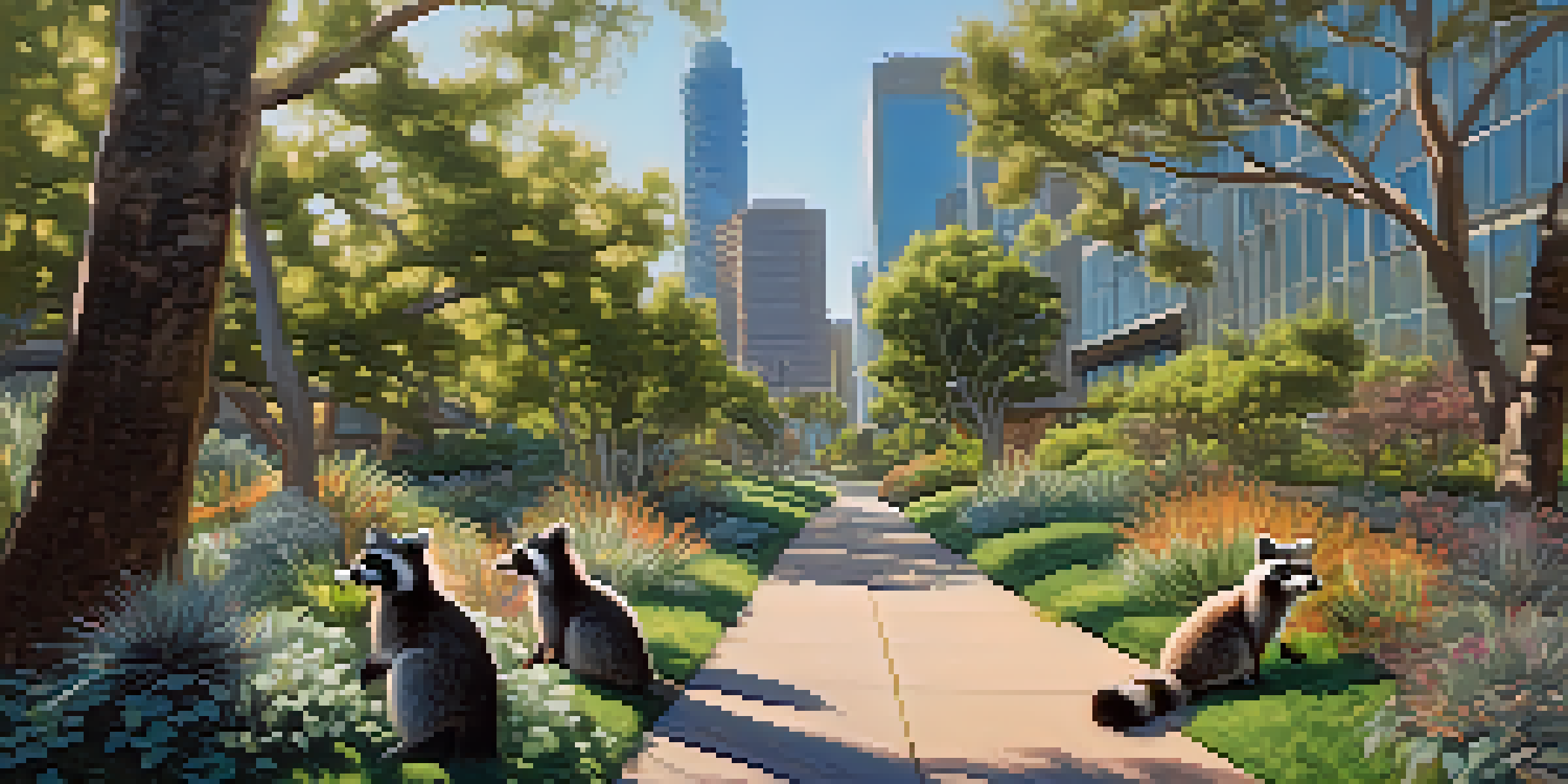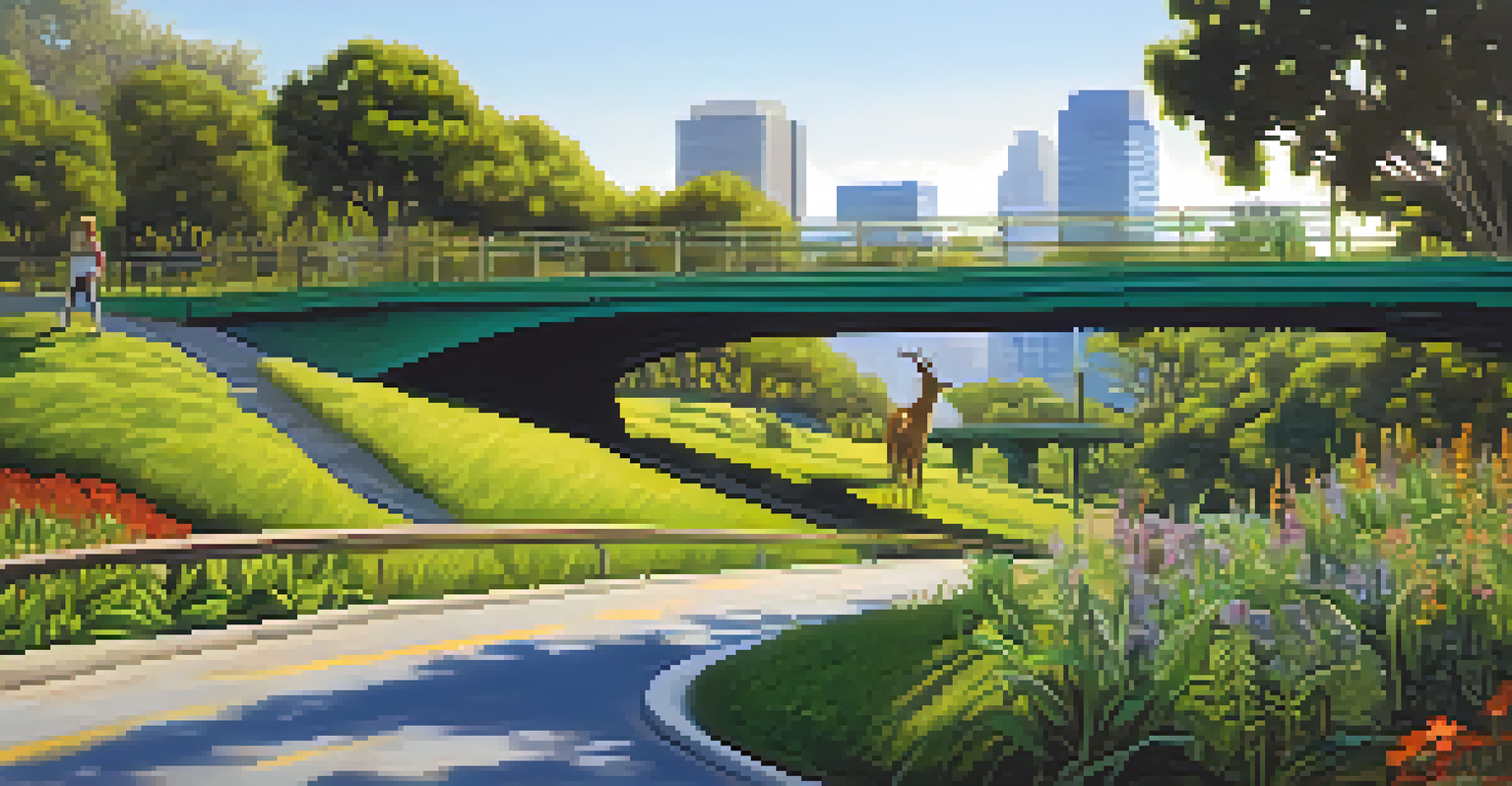Connecting Urban Parks for Enhanced Wildlife Movement in LA

Understanding the Importance of Urban Wildlife Corridors
Urban wildlife corridors are essential for connecting habitats and allowing animals to move freely across city landscapes. These corridors facilitate genetic diversity, which is crucial for the survival of various species. When wildlife can roam without barriers, they can find food, mates, and safe nesting areas more easily.
In the end, we will conserve only what we love; we will love only what we understand; and we will understand only what we are taught.
In Los Angeles, where urbanization has fragmented many natural habitats, establishing these connections is vital. For instance, a coyote or a raccoon may travel through parks to reach their preferred habitats, but barriers like highways can pose significant threats to their movement. By understanding the importance of these corridors, we can better appreciate the role they play in maintaining healthy ecosystems.
Ultimately, creating urban wildlife corridors is not just about wildlife; it also benefits humans by enhancing local biodiversity and improving overall ecological health. Studies have shown that areas with rich wildlife populations often experience better air and water quality, making these corridors beneficial for everyone.
Current Challenges Facing Urban Wildlife in LA
Los Angeles presents a unique set of challenges for urban wildlife due to its sprawling nature and dense population. Habitat fragmentation caused by roads, development, and pollution creates obstacles for animals that need to move between parks. This fragmentation can lead to isolated populations that struggle to thrive, as they lose access to critical resources.

Additionally, human activities often disrupt wildlife patterns, whether it's through noise, light pollution, or direct interaction. For example, deer might hesitate to cross a busy road, and birds may avoid nesting in areas with high foot traffic. These disturbances can significantly impact local species, leading to declining numbers and even local extinctions.
Wildlife Corridors Enhance Biodiversity
Urban wildlife corridors play a crucial role in connecting habitats, promoting genetic diversity, and supporting healthy ecosystems.
To address these issues, it's essential to recognize the need for strategic planning and community engagement in habitat restoration. By working together, urban planners and local residents can create environments that are safe and accessible for wildlife while still accommodating human activities.
The Role of Parks in Supporting Urban Wildlife
Parks play a crucial role in providing refuge and resources for wildlife in urban settings. They serve as vital green spaces where animals can find food, shelter, and breeding grounds. In LA, parks like Griffith Park and Elysian Park are not only recreational spaces for people but also habitats for various species, from birds to small mammals.
The future will be shaped by the choices we make today. Let's make them good ones for wildlife and ourselves.
Moreover, well-designed parks can act as stepping stones, enabling wildlife to traverse urban areas safely. Features such as native plant gardens, water sources, and natural landscapes help attract and support diverse wildlife populations. This creates a win-win situation: people enjoy nature while wildlife flourishes.
By enhancing and maintaining these parks, cities can ensure that wildlife has access to essential resources. This not only enriches the urban ecosystem but also fosters a sense of community connection to nature, encouraging residents to appreciate and protect their local environment.
Designing Effective Wildlife Corridors in LA
Designing effective wildlife corridors involves strategic planning and a deep understanding of local ecosystems. Corridors should connect existing parks and natural areas, allowing animals to move seamlessly between them. This could mean creating green bridges over highways or preserving existing pathways like riverbanks and trails.
Incorporating native vegetation into these corridors is key, as it provides food and shelter for local wildlife. For instance, a corridor lined with native plants can attract pollinators and other beneficial species, creating a vibrant ecosystem. Such designs not only support wildlife but also enhance the beauty of urban landscapes.
Community Engagement is Key
Local residents can significantly impact wildlife initiatives by participating in advocacy and conservation efforts.
Community input is also vital in designing these corridors. Engaging local residents in the planning process can help identify critical areas for wildlife movement and ensure that the corridors meet both ecological and community needs.
Case Studies: Successful Wildlife Corridor Initiatives
Looking at successful initiatives can provide valuable insights into creating effective wildlife corridors. One notable example is the Santa Monica Mountains Connectivity Project, which aims to connect fragmented habitats through a network of protected lands. This project has shown how collaborative efforts can lead to meaningful improvements in wildlife movement.
Another inspiring case is the establishment of the Wildlife Way Station, which acts as a sanctuary for displaced wildlife. By creating safe havens and connecting them to urban parks, the Way Station illustrates how proactive measures can protect and rehabilitate local species.
These examples highlight the importance of collaboration between governmental agencies, non-profits, and the community. By sharing resources and knowledge, stakeholders can work together to create corridors that truly benefit urban wildlife while enhancing the quality of life for residents.
Community Involvement in Wildlife Movement Initiatives
Engaging the community is crucial for the success of wildlife movement initiatives. Local residents can play a significant role in advocating for and participating in the creation of wildlife corridors. By raising awareness about the importance of wildlife, communities can foster a sense of stewardship and responsibility toward the local ecosystem.
Organizing volunteer programs for park clean-ups, native plantings, and educational workshops can empower residents to take action. These activities not only enhance local habitats but also strengthen community bonds as people come together for a common cause. The more involved residents are, the more likely they are to support ongoing conservation efforts.
Parks Support Urban Wildlife
Well-designed parks provide essential resources and safe passage for wildlife, benefiting both animals and city dwellers.
Moreover, sharing success stories and information about local wildlife can inspire others to get involved. By fostering a culture of appreciation for urban wildlife, communities can encourage sustainable practices that benefit both nature and urban living.
The Future of Urban Wildlife Movement in Los Angeles
The future of urban wildlife movement in Los Angeles looks promising, especially as awareness and advocacy for wildlife corridors continue to grow. With increasing support from community members and organizations, there’s potential for significant improvements in how wildlife navigates the urban landscape. This shift not only helps protect local species but also enhances the overall quality of life for residents.
Innovative approaches, such as integrating technology into wildlife monitoring and corridor design, could further enhance these efforts. For example, using cameras and sensors can help track animal movements and identify areas needing improvement. This data-driven approach can lead to more effective planning and implementation of wildlife corridors.

Ultimately, the collaboration between residents, city planners, and conservationists will shape the future landscape of LA. By working together, everyone can contribute to a city that not only supports thriving wildlife populations but also embraces the natural beauty that enriches urban life.